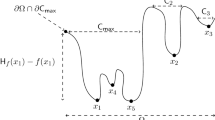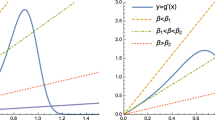Abstract
The large time behavior of a stochastic system with infinitesimally small noise can be described in terms of Freidlin’s cycles. We show that if the system is gradient and the potential satisfies certain non-restrictive conditions, the hierarchy of cycles has a structure of a full binary tree, and each cycle is exited via the lowest saddle adjacent to it. Exploiting this property, we propose an algorithm for computing the asymptotic zero-temperature path and building a hierarchy of Freidlin’s cycles associated with the transition process between two given local equilibria. This algorithm is suitable for systems with a complex potential energy landscape with numerous minima. We apply it to find the asymptotic zero-temperature path and Freidlin’s cycles involved into the transition process between the two lowest minima of the Lennard-Jones cluster of 38 atoms. D. Wales’s stochastic network of minima and transition states of this cluster is used as an input.









Similar content being viewed by others
Notes
The network available at the Wales group web site is not connected. Its maximal connected component consists of 71887 minima. This component contains FCC and ICO.
There is a typo in [7] in the second paragraph on page 338: \(m_{C}(i)=V_{iJ(i)}-V_{k^{\ast}J(k^{\ast})}\) should be replaced with \(m_{C}(i)=V_{k^{\ast}J(k^{\ast})}-V_{iJ(i)}\).
References
Becker, O.M., Karplus, M.: The topology of multidimensional potential energy surfaces: theory and application to peptide structure and kinetics. J. Chem. Phys. 106, 1495–1517 (1997)
Cameron, M., Kohn, R.V., Vanden-Eijnden, E.: The string method as a dynamical system. J. Nonlinear Sci. 21(2), 193–230 (2011)
Carr, J.M., Trigubenko, S.A., Wales, D.J.: Finding pathways between distant local minima. J. Chem. Phys. 122, 234903 (2005)
Dijkstra, E.W.: A note on two problems in connexion with graphs. Numer. Math. 1, 269–271 (1959)
Doye, J.P.K., Miller, M.A., Wales, D.J.: The double-funnel energy landscape of the 38-atom Lennard-Jones cluster. J. Chem. Phys. 110, 6896–6906 (1999)
Freidlin, M.I.: Sublimiting distributions and stabilization of solutions of parabolic equations with small parameter. Sov. Math. Dokl. 18(4), 1114–1118 (1977)
Freidlin, M.I.: Quasi-deterministic approximation, metastability and stochastic resonance. Physica D 137, 333–352 (2000)
Freidlin, M.I., Wentzell, A.D.: Random Perturbations of Dynamical Systems, 2nd edn. Springer, New York (1998)
Hamilton, J.C., Siegel, D.J., Uberuaga, B.P., Voter, A.F.: Isometrization rates and mechanisms for the 38-atom Lennard-Jones cluster determined using molecular dynamics and temperature accelerated molecular dynamics. Available via http://www-personal.umich.edu/~djsiege/Energy_Ctorage_Lab/Publications_files/LJ38_v14.eps
Mandelshtam, V.A., Frantsuzov, P.A.: Multiple structural transformations in Lennard-Jones clusters: generic versus size-specific behavior. J. Chem. Phys. 124, 204511 (2006)
Metzner, P., Schuette, Ch., Vanden-Eijnden, E.: Transition path theory for Markov jump processes. Multiscale Model. Simul. 7(3), 1192–1219 (2008)
Neirotti, J.P., Calvo, F., Freeman, D.L., Doll, J.D.: Phase changes in 38-atom Lennard-Jones clusters. I. A parallel tempering study in the canonical ensemble. J. Chem. Phys. 112, 10340 (2000)
Norris, J.R.: Markov Chains. Cambridge University Press, Cambridge (1997)
Picciani, M., Athenes, M., Kurchan, J., Taileur, J.: Simulating structural transitions by direct transition current sampling: the example of LJ38. J. Chem. Phys. 135, 034108 (2011)
Vanden-Eijnden, E.: Transition Path Theory. Lecture Notes in Physics, vol. 703, pp. 439–478. Springer, Berlin/Heidelberg (2006)
Vanden-Eijnden, E., Heymann, M.: The geometric minimum action method for computing minimum energy paths. J. Chem. Phys. 128, 061103 (2008)
Wales, D.J.: Discrete path sampling. Mol. Phys. 100, 3285–3306 (2002)
Wales, D.J.: Some further applications of discrete path sampling to cluster isomerization. Mol. Phys. 102, 891–908 (2004)
Wales, D.J.: Energy landscapes: calculating pathways and rates. Int. Rev. Phys. Chem. 25(1–2), 237–282 (2006)
Wales, D.J.: Website contains the database for the Lennard-Jones-38 cluster. Available via http://www-wales.ch.cam.ac.uk/examples/PATHSAMPLE
Wales, D.J., Doye, J.P.K.: Global optimization by basin-hopping and the lowest energy structures of Lennard-Jones clusters containing up to 110 atoms. J. Phys. Chem. A 101, 5111–5116 (1997)
Wales, D.J., Miller, M.A., Walsch, T.R.: Archetypal energy landscapes. Nature 394, 758–760 (1998)
Weinan, E., Ren, W., Vanden-Eijnden, E.: String method for study of rare events. Phys. Rev. B 66, 052301 (2002)
Weinan, E., Ren, W., Vanden-Eijnden, E.: Simplified and improved string method for computing the minimum energy paths in barrier-crossing events. J. Chem. Phys. 126, 164103 (2007)
Acknowledgements
I thank Prof. David Wales for referring me to his LJ38 network and helping to interpret the data files. I am grateful to Prof. Eric Vanden-Eijnden for valuable discussion. I thank Prof. Mark Freidlin for valuable remarks and advice. This work is supported by the Alfred Sloan foundation, by the DARPA YFA Grant N66001-12-1-4220, and the NSF grant 1217118.
Author information
Authors and Affiliations
Corresponding author
Additional information
Alfred Sloan foundation, DARPA YFA N66001-12-1-4220, NSF grant 1217118.
Appendix
Appendix
Proof
(Lemma 3) For zero order cycles consisting of a single state, the main state is the state itself. Hence Lemma 3 holds straightforwardly. For first order cycles, the main state is defined as follows [7]. Let C be a first order cycle. Then its main state is
Using Eq. (3) we obtain
First order cycles are constructed identically in this work and in [6–8]. Hence Lemma 1 claiming that first order cycles consist of exactly two states holds. Let C={i,j} be a first order cycle. Suppose V j <V i . Then
Hence Lemma 3 holds for first order cycles.
In [6–8], the main state for higher order cycles is defined via the concept of i-graph.
Definition 6
Let S be a set of states and i be a selected state. Then an i-graph is a directed graph G(S,E) satisfying the following properties.
-
1.
Every state m∈S∖{i} is the initial point of exactly one arrow.
-
2.
For any state m∈S∖{i} there exists a sequence of arrows leading from m to i.
Let C be a kth order cycle where k≥2. Then the main state M(C) is given by
Here G j (C) is the collection of all j-graphs defined on the cycle C and ∑(m→n)∈g is the sum over all edges of the j-graph g. Using Eq. (3) we rewrite Eq. (47) as

We have split the sum into two sums, the sum over all saddles and the sum over all minima associated with the j-graph g. The sum in Eq. (48) is minimized over all i-graphs that may be defined on the set of states C. Next we make the following the following two observations.
Observation 1
The union
can be obtained as follows. Let T(C) be the collection of all trees on C. We remind that a tree is an undirected graph in which any two vertices are connected by exactly one simple path (i.e., a path with no repeated vertices). Then for every tree t∈T(C) and every state j∈C we can define a j-graph. We note that
where the tree t(g) is obtained from the directed graph g by making all its edges undirected. This means that the minimum value of the sum over all saddles associated with a j-graph g is completely determined by the tree t(g) corresponding to this graph. Hence the sum over the saddles does not influence argmin j∈C in Eq. (48). Figure 10 illustrates this phenomenon for the second order cycle {A,B,C} in the 3-well potential example in Sect. 2.1.
Illustration for the proof of Lemma 3. The collections of i-graphs for each state of the second order cycle C={A,B,C} in the 3-well potential example in Sect. 2.1. Obviously, there exist three different trees for the set of vertices {A,B,C}. For each of the states A, B, and C, the collection of i-graphs is obtained from these trees
Observation 2
Next we observe that the second sum in Eq. (48) is completely determined by the state j, i.e., it is independent of the j-graph g. Indeed, since g is connected, the second sum in Eq. (48) contains the values of the potential at all states but one: the state j.
Taking into account Observations 1 and 2 we rewrite Eq. (48) as

Therefore, the main state of a cycle C is its deepest minimum. □
Proof
(Lemma 4) For a first order cycle C, the stationary distribution rate is defined by [7]Footnote 2
By Lemma 1, first order cycles consist of two states: C=i∪j. Let V j <V i , i.e., j is the main state of the cycle C. Then Eq. (51) becomes

Hence the claim holds for the first order cycles.
For higher order cycles, the stationary distribution rate is defined as
Using Eq. (3) we rewrite Eq. (53) as

Taking into account Observations 1 and 2 made in the proof of Lemma 3 we get

Thus, Lemma 4 holds for cycles of order k≥2 as well. □
Proof
(Lemma 5) The exit rate [7] of a cycle C is defined by
Using Eq. (3) and Lemma 4 we rewrite Eq. (56) as

This completes the proof. □
Rights and permissions
About this article
Cite this article
Cameron, M.K. Computing Freidlin’s Cycles for the Overdamped Langevin Dynamics. Application to the Lennard-Jones-38 Cluster. J Stat Phys 152, 493–518 (2013). https://doi.org/10.1007/s10955-013-0770-4
Received:
Accepted:
Published:
Issue Date:
DOI: https://doi.org/10.1007/s10955-013-0770-4





